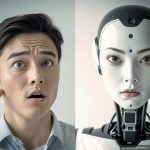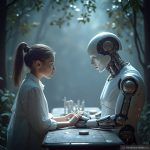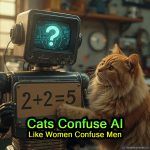The Future and Soul of Movie Making
Why Human-Made Films Will Outlast AI
Cinematography doesn’t just capture stories — it alters reality. From the flickering glow of a black-and-white classic to the hyper-realistic CGI of modern blockbusters, movies shape how we see the world, dream, and even live our lives. A single film can inspire generations, redefine culture, or make us question our existence. And this is just the beginning.
The Power of Cinematography: How Movies Rewire Humanity
Motion pictures do not just reflect life — they rewrite it. From the haunting shadows of Nosferatu shaping our fear of the dark to the sweeping heroism of Star Wars inspiring generations to reach for the stars, films alter how we think, feel, and even exist. They implant memories we never lived, forge emotions we’ve never felt, and redefine morality with a single frame. A well-crafted shot can make us question reality — “Is this how love looks?” “Is this how war feels?” — until fiction bleeds into truth.
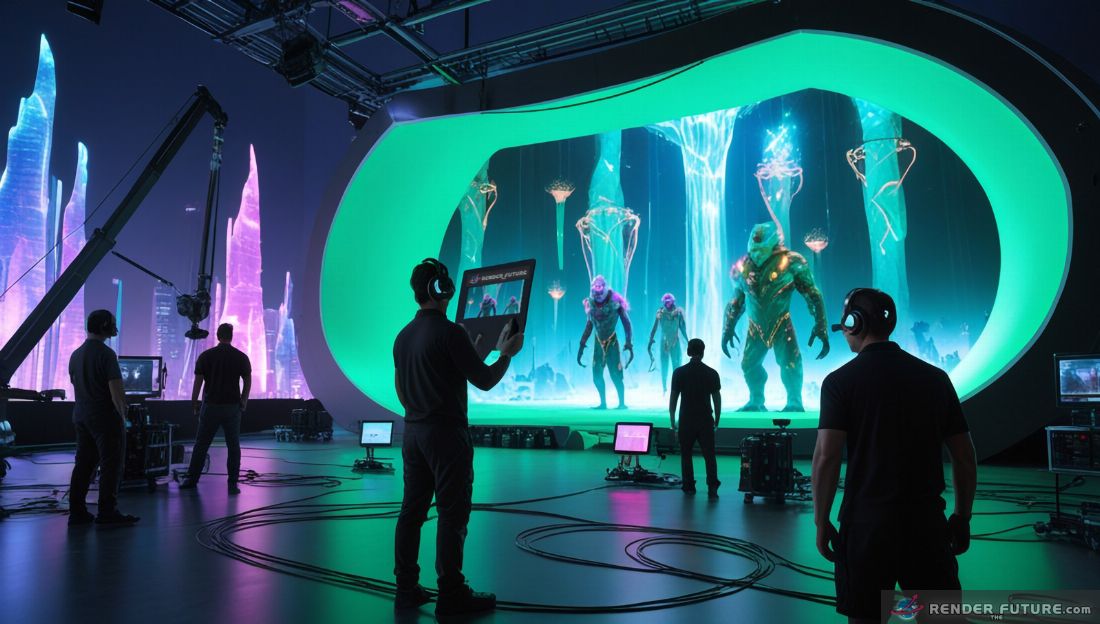
And it’s not just about money — it’s about illusion. The magic of 24 frames per second, a standard born from early film experiments, creates a hypnotic effect. Unlike the crisp 60fps of sports broadcasts, 24fps flickers just enough to lull viewers into a dreamlike state, making three-hour epics feel like fleeting moments. It’s a psychological trigger. And as technology evolves, this power will only grow — the representation of the virtual worlds so real they blur the line between spectator and participant, stories that adapt to our deepest fears and desires.
Cinematography isn’t just entertainment. It’s collective hypnosis, and humanity is under its spell.
The future of movie making — or rather, cinematography — is on the verge of a new revolution.
Imagine films that don’t just show you a story but pull you inside it. Worlds built not only by set designers but downloaded from human imagination. Stunt sequences performed by new flexible material robotic doubles, indistinguishable from real actors. Stories that adapt to your emotions in real-time.
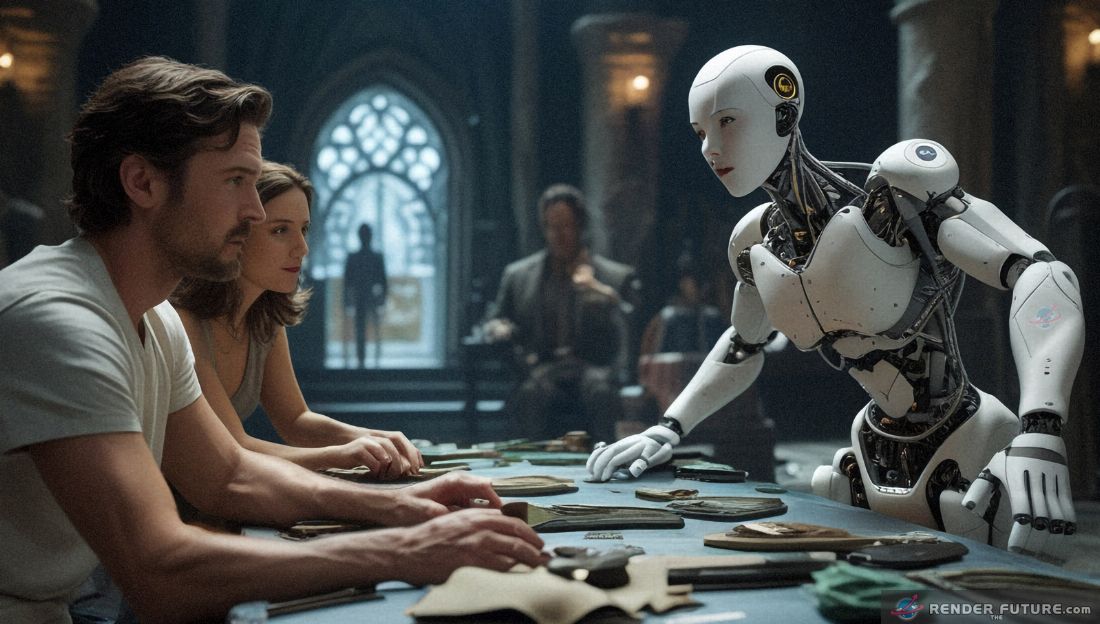 And as technology evolves, this power will only grow — virtual worlds so real they blur the line between spectator and participant, stories that adapt to our deepest fears and desires.
And as technology evolves, this power will only grow — virtual worlds so real they blur the line between spectator and participant, stories that adapt to our deepest fears and desires.
This isn’t science fiction. It’s the next chapter of an art form that has always pushed boundaries.
The Immense Effort Behind Every Frame
Before we leap into the future, let’s pause and truly appreciate the staggering human achievement that is modern filmmaking.
A major Hollywood production isn’t just a two-hour escape — it’s the culmination of thousands of lives, each dedicating years of sweat, ingenuity, and passion to a single shared vision.
Take Avatar: The Way of Water — a film that took over a decade to perfect, requiring breakthroughs in underwater motion capture, photorealistic CGI, and entirely new filmmaking techniques just to bring James Cameron’s vision to life.
For the price of a $20 ticket, you’re not just watching a movie — you’re witnessing a 200+ million masterpiece, a symphony of artists, engineers, and visionaries working in perfect harmony.
If one person tried to make a blockbuster alone, it would take centuries
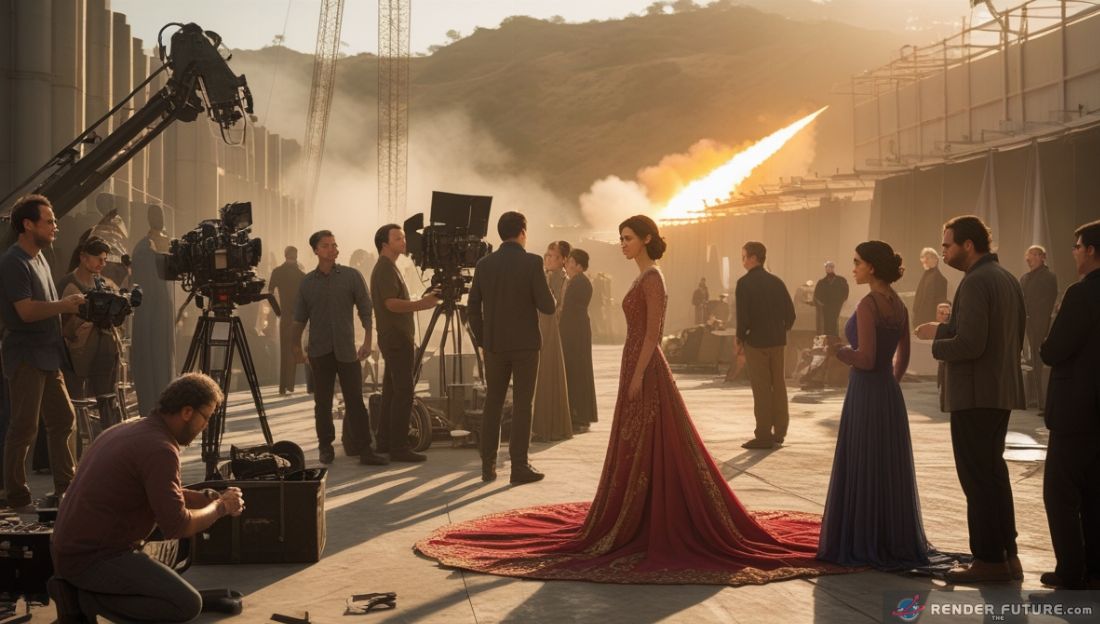 But a film crew? They bend time. They pull the future into the present, crafting entire universes before our eyes. Every frame is a mosaic of effort — set builders painstakingly recreating historical eras, costume designers hand-stitching garments with period-accurate detail, VFX artists rendering explosions pixel by pixel until they feel real. Even the simplest shot — a character walking down a street — might involve location scouts, lighting technicians, sound engineers, and continuity supervisors, all ensuring that single moment feels seamless.
But a film crew? They bend time. They pull the future into the present, crafting entire universes before our eyes. Every frame is a mosaic of effort — set builders painstakingly recreating historical eras, costume designers hand-stitching garments with period-accurate detail, VFX artists rendering explosions pixel by pixel until they feel real. Even the simplest shot — a character walking down a street — might involve location scouts, lighting technicians, sound engineers, and continuity supervisors, all ensuring that single moment feels seamless.
And then there’s the unseen labor…
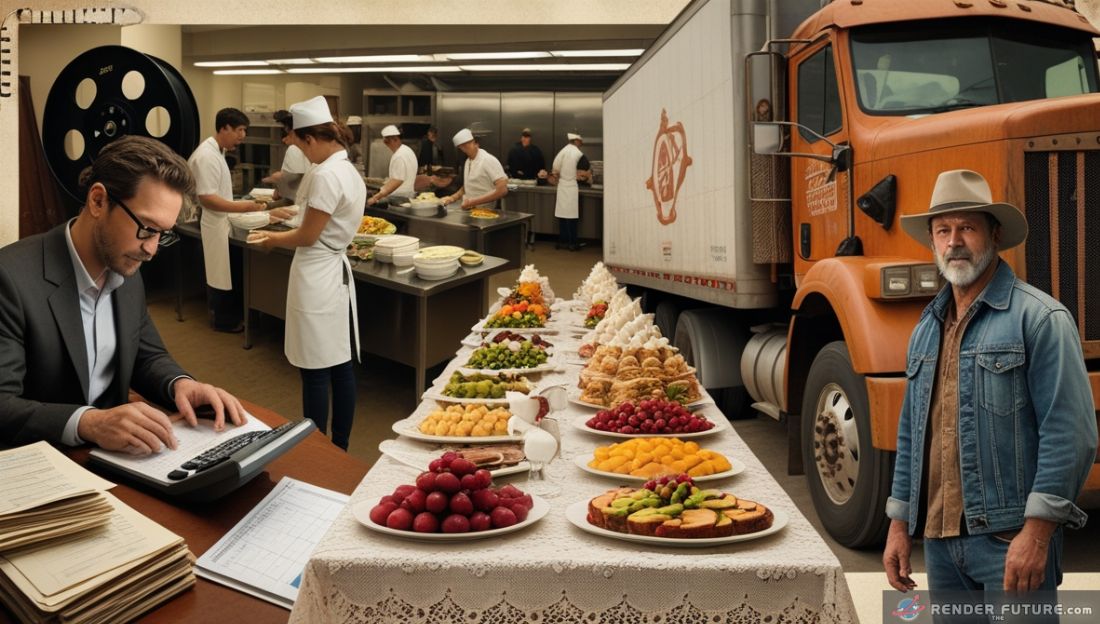 The accountants managing budgets down to the penny, the caterers feeding hundreds of crew members, the drivers transporting equipment across continents. A single film is a temporary civilization, a self-contained world that exists only to create magic. When you sit in a theater, you’re not just watching actors on a screen — you’re seeing the combined effort of thousands of people who devoted months or years of their lives to a single story.
The accountants managing budgets down to the penny, the caterers feeding hundreds of crew members, the drivers transporting equipment across continents. A single film is a temporary civilization, a self-contained world that exists only to create magic. When you sit in a theater, you’re not just watching actors on a screen — you’re seeing the combined effort of thousands of people who devoted months or years of their lives to a single story.
Perhaps most astonishing is how fragile this alchemy is. One mistimed cue, one misplaced prop, one misaligned green screen — and the illusion shatters. Yet, against all odds, it works.
Day after day, take after take, the “machine” keeps moving forward until, finally, the pieces lock into place. That’s the true miracle of filmmaking: not the technology, not the stars, but the sheer human will required to make the impossible feel effortless.
The next time you lose yourself in a film, remember — you’re not just being entertained. You’re witnessing one of the most complex collaborative art forms ever created.
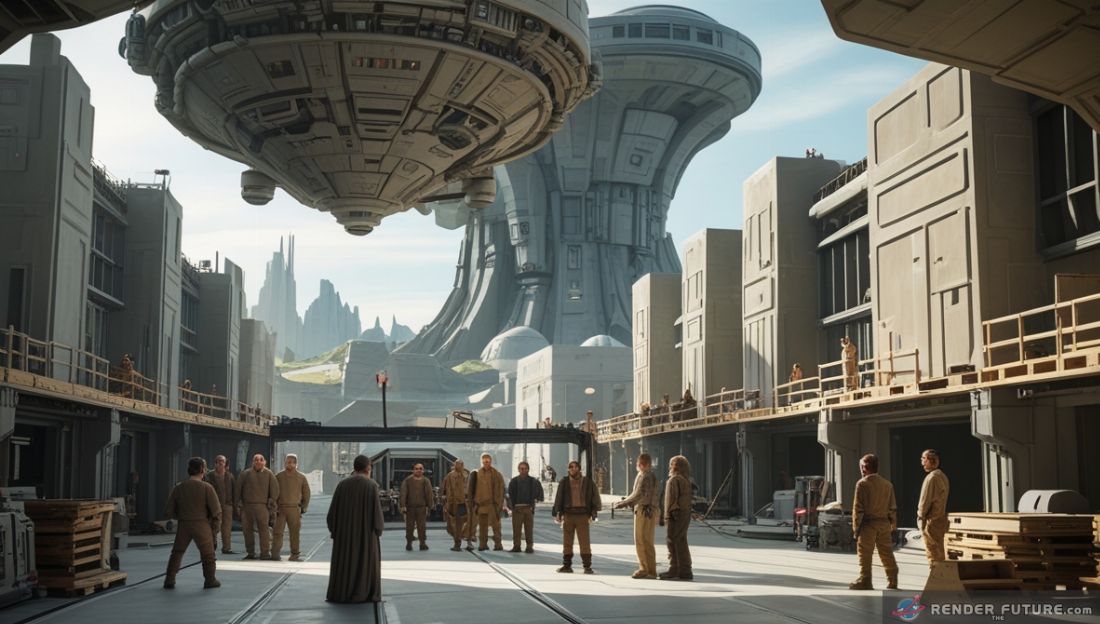
The Digital Revolution: AI, VR, and Brain-Generated Worlds
1. AI as a Collaborator, Not a Replacement
The fear is real: Will AI replace filmmakers? The short answer: No. The long answer? AI will reshape everything.
Imagine an AI that drafts scripts based on centuries of storytelling wisdom. Or a neural network that generates concept art from a director’s vague description: “A cyberpunk city where it rains diamonds.” Boom — instant visualization.
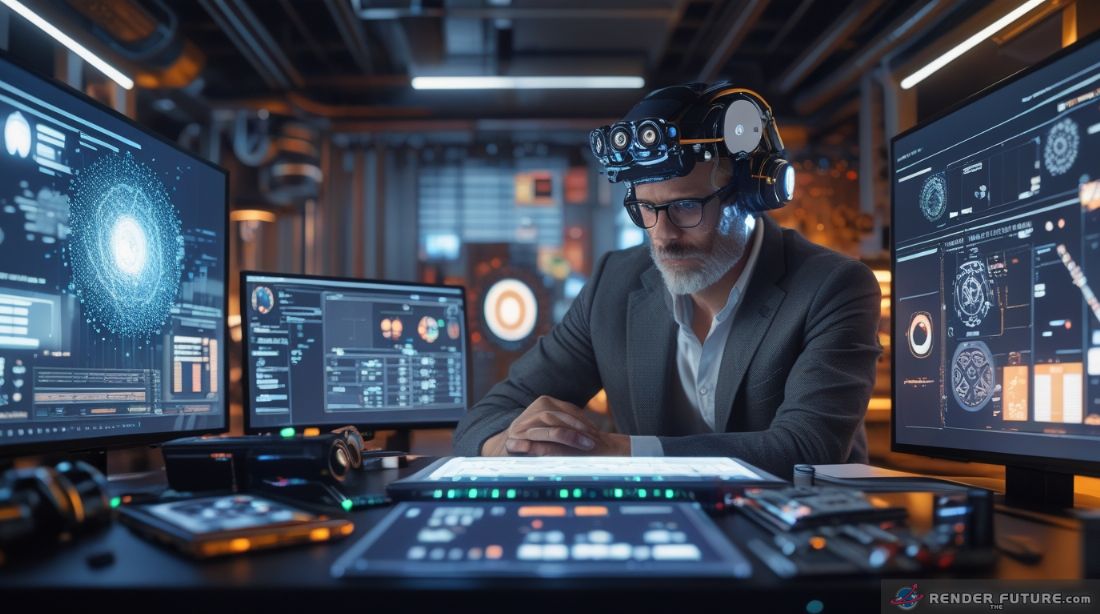
But here’s the twist: AI lacks soul. It can’t channel heartbreak from a bad breakup or the euphoria of falling in love. It can’t improvise like an actor or rewrite a scene on set because the lighting felt wrong.
The future isn’t AI versus humans — it’s AI empowering humans. The best filmmakers will wield AI like a paintbrush, not let it replace the artist.
2. The Dawn of Thought-Projected Storytelling
What if a director could download a dream and turn it into a movie scene? Emerging tech suggests we’re heading there. Brain-computer interfaces could one day translate mental imagery directly into digital environments, making CGI feel organic, almost alive.
Now imagine a world where filmmakers create not just with cameras, but with their minds. Emerging neurotechnology is already experimenting with brainwave-driven art, where EEG headsets can translate mental images into rough visualizations.
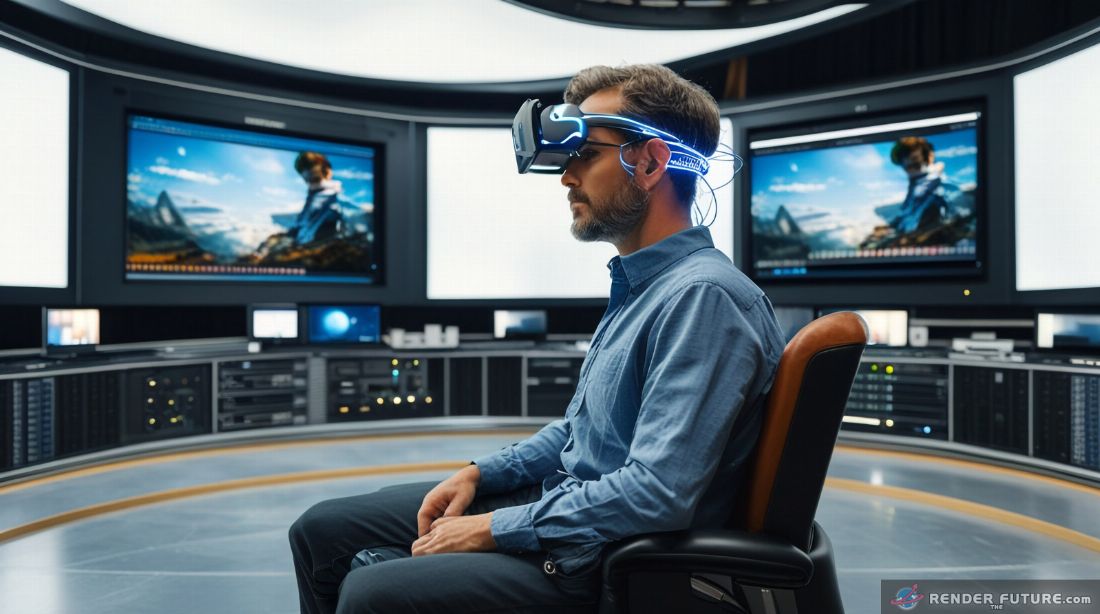
The next step? Refining this into full cinematic sequences, where a director’s unfiltered imagination — the haunting landscapes of their nightmares, the euphoric colors of their happiest memories — could be instantly rendered into filmable scenes. This wouldn’t just revolutionize CGI; it would democratize visual storytelling itself. A child in Mumbai, a war refugee in Kyiv, or an Indigenous elder in the Amazon could “record” their stories directly from their minds, preserving cultures and perspectives in ways cameras never could.
Yet even as this tech blossoms, its greatest power may lie in collaboration — not replacement. The rawness of a hand-built set, the electricity of actors reacting in real time, the happy accidents of practical effects — these are the textures that make cinema human. The future won’t erase them; it’ll give us new tools to make them even more extraordinary.
Yet, practical filmmaking won’t die. Just as vinyl records made a comeback, audiences will always crave real sets, real actors, and real emotion. Digital and physical cinema will coexist — each with its own audience.
3. Robotic Stunt Doubles and Shape-Shifting Materials
Why risk Tom Cruise dangling from a plane when a robotic clone can do it flawlessly? Future films will use AI-driven animatronics and morphing materials to create impossible stunts — safely.
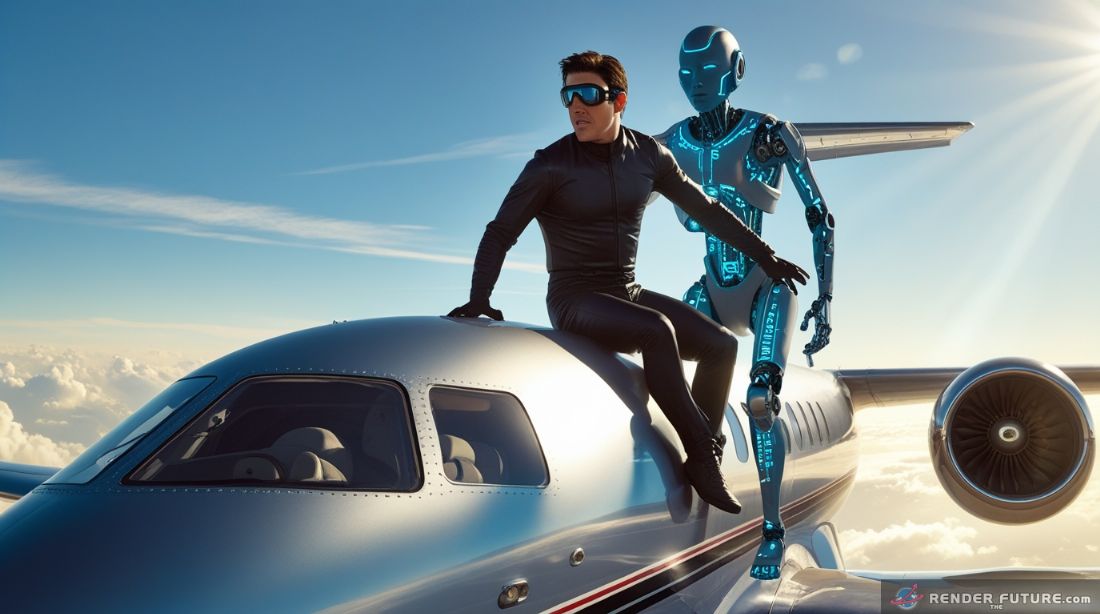
But here’s the catch: If robots do all the action, what happens to stunt performers? The industry will face turbulence, but new roles will emerge — robot choreographers, AI emotion trainers, hybrid directors blending live and digital performances.
While robotic stunt doubles promise unprecedented safety and precision, they’ll never fully replicate the ingenuity of human stunt performers — the split-second improvisation when a jump goes wrong, the lived-in physicality of a seasoned fighter, or the subtle imperfections that make action feel visceral. The most thrilling sequences of the future may actually be collaborations between humans and machines, where a stunt performer’s expertise trains an AI model to mimic their signature style, or where shape-shifting exosuits amplify — rather than replace — an actor’s movements.
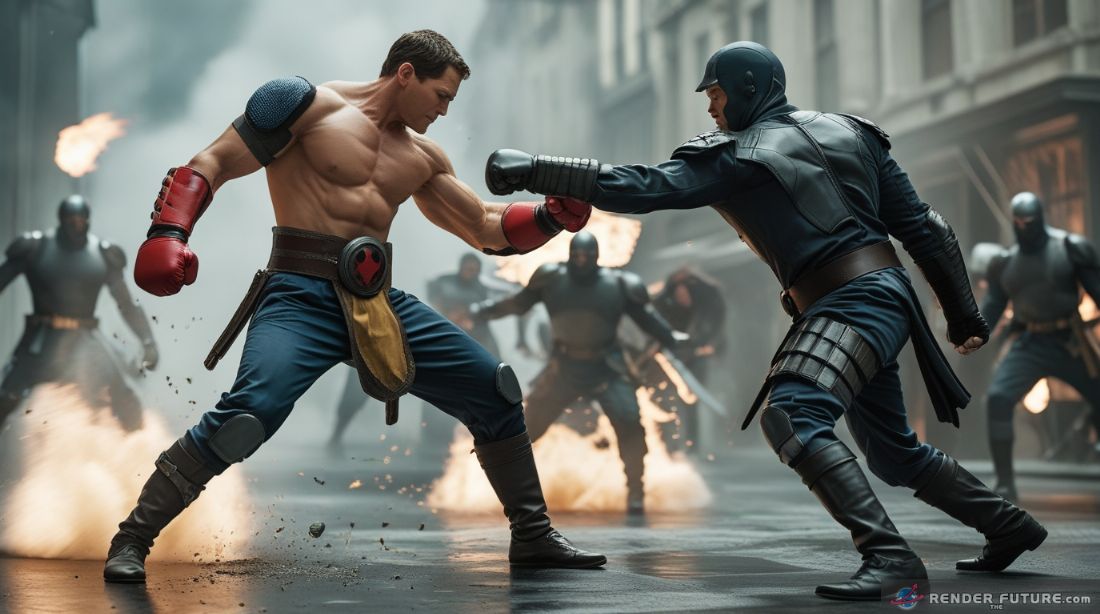 Visualize a fight scene where the hero’s costume stiffens on impact to protect them, then flows like liquid for the next strike, all while preserving the raw energy of real combat. The magic won’t be in eliminating risk, but in redistributing it — keeping the danger where it belongs (on screen) while honoring the artists who make it believable.
Visualize a fight scene where the hero’s costume stiffens on impact to protect them, then flows like liquid for the next strike, all while preserving the raw energy of real combat. The magic won’t be in eliminating risk, but in redistributing it — keeping the danger where it belongs (on screen) while honoring the artists who make it believable.
Personalized and Interactive Storytelling
Movies Where You Become Part of the Story
Envision this: Instead of just watching a movie, you’re actually in it – making choices that change what happens next. This isn’t science fiction anymore. Thanks to virtual reality, we’re entering a new era of filmmaking where the audience gets to play an active role.

While traditional movies will always have their place (sometimes you just want to relax and let the story carry you), interactive films will become their own exciting category. Picture yourself stepping into a mystery where you decide which clues to follow, or a romance where your choices determine how the relationship unfolds. It’s like being the main character in your favorite story.
This isn’t just about pressing buttons to pick options – VR technology will let you naturally interact with the world around you. The movie reacts to where you look, how you move, even your facial expressions. It’s storytelling that breathes and changes with you.
The best part? These interactive experiences won’t replace regular movies – they’ll exist alongside them as a whole new way to experience stories. Just as streaming didn’t kill theaters, interactive films will simply give us more ways to enjoy great storytelling.
The future of movies isn’t just about watching – it’s about living the story.
The Big Screen Isn’t Going Anywhere
Let’s be real – watching a movie at home in your pajamas is great. But remember that time you saw that huge plot twist in a packed theater? When the entire audience gasped so loud you could feel it in your bones? That’s magic no streaming service can deliver.
Theaters are like concert halls for movies. You don’t just watch – you feel it. The bass that vibrates through your seat, the screen so big it fills your vision, that contagious energy when everyone laughs or screams together. It’s why we still go out for steak dinners when we have microwaves at home.
And get this – theaters are about to level up big time. Imagine:
- Smelling the pine trees in a forest scene
- Feeling actual mist during a rainy sequence
- Your seat tilting just slightly during chase scenes and where 4D seats that rumble with explosions and sway with flying scenes
- Interactive armrests that let you vote on alternate endings
- Biometric seats that adjust intensity based on your heart rate
- “Memory foam” seats that reshape for optimal comfort
- “Behind the scenes” view toggles revealing VFX layers
- Haptic vests for full-body immersion during action sequences
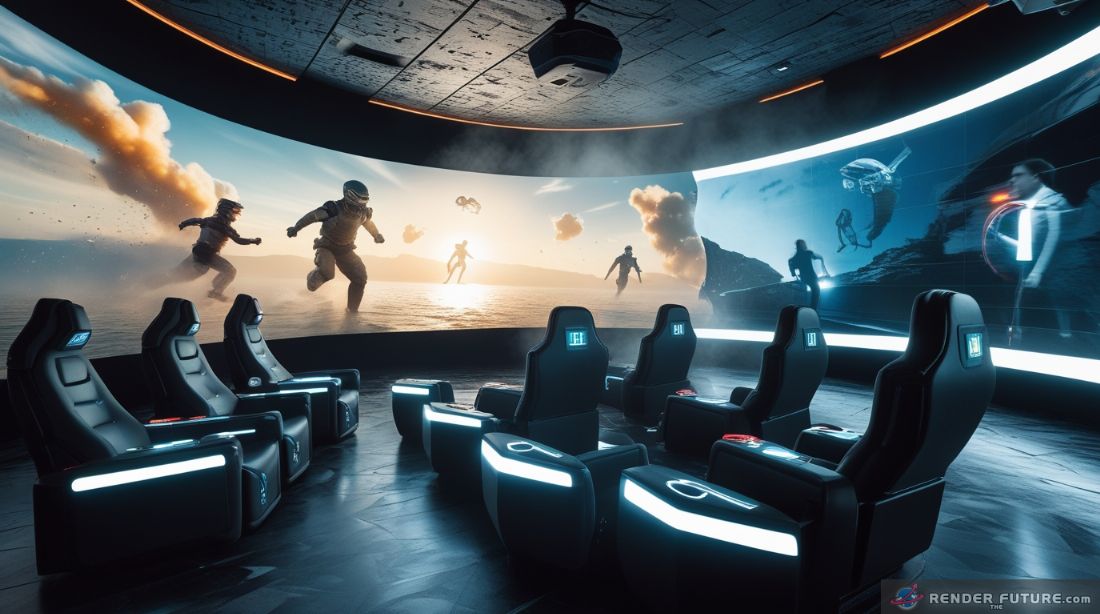
The common thread? Making the shared experience even more magical while keeping what we love – the giant screen, earth-shaking sound, and that irreplaceable collective energy. Because sometimes, you just need to be in a room where 300 people all scream “NO WAY!” at exactly the same moment.
The future of cinema isn’t just about better pixels – it’s about creating moments we’ll all remember together. Because at the end of the day, the best stories are the ones we experience side by side, not alone on our couches.
That shared “holy crap!” moment? That’s forever.
Challenges and Hope for the Future
The AI Job Crisis (And Why It’s Temporary)
Y es, AI will disrupt jobs — editors, VFX artists, even writers may feel the squeeze. But history shows technology reshapes labor rather than erases it. When sound replaced silent films, new roles emerged. The same will happen here.
es, AI will disrupt jobs — editors, VFX artists, even writers may feel the squeeze. But history shows technology reshapes labor rather than erases it. When sound replaced silent films, new roles emerged. The same will happen here.
The key? Adaptation. Future filmmakers must master AI tools while preserving human artistry. Studios should invest in re-skilling programs, ensuring no talent is left behind.
The most exciting opportunities will live at the intersection of human and machine creativity
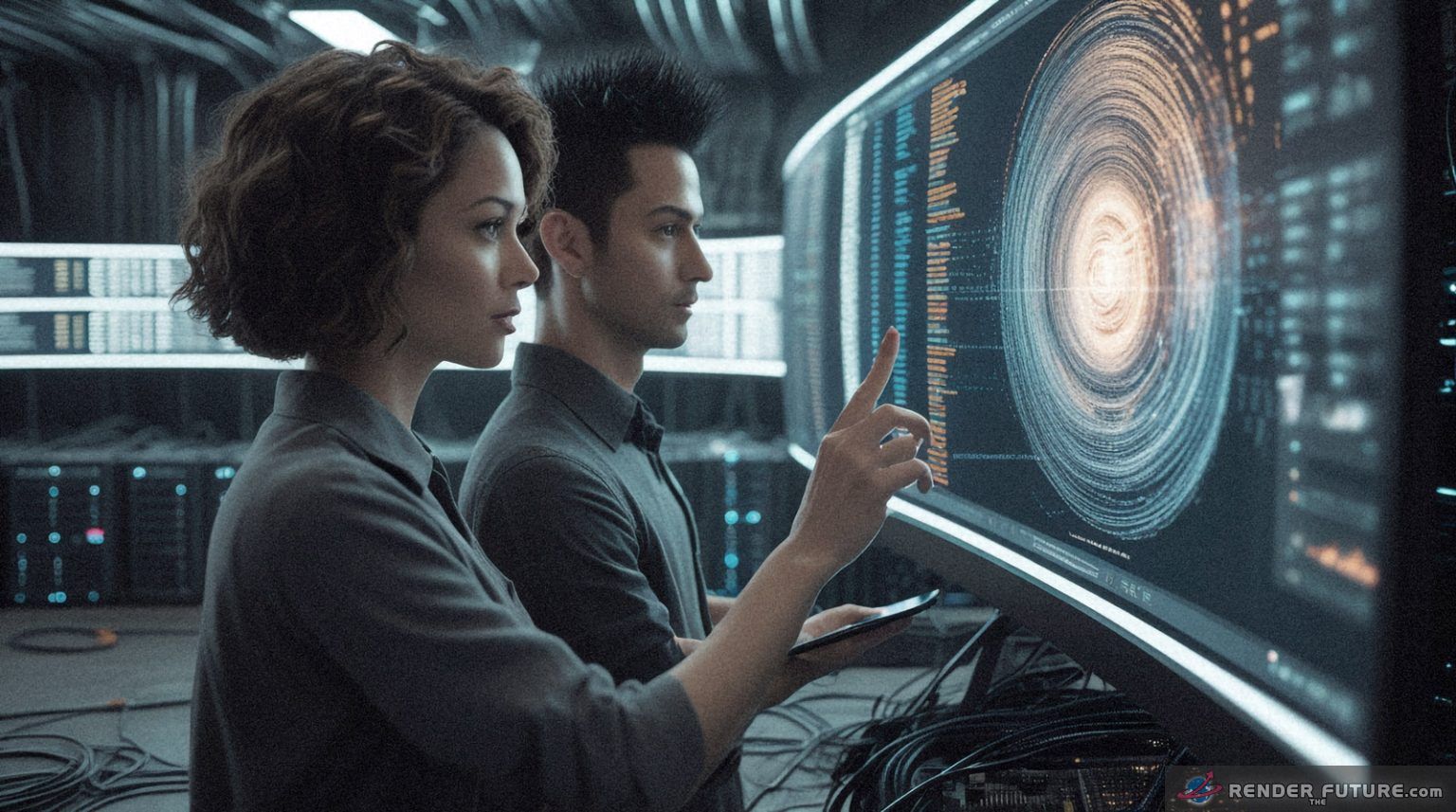 Imagine ‘AI whisperers’ who sculpt raw algorithmic output into emotional storytelling, or hybrid technicians who blend practical effects with digital enhancements. This isn’t about humans versus machines, but about artists wielding new tools to push boundaries we haven’t even imagined yet. The filmmakers who thrive will be those who treat AI like a collaborator rather than a competitor, using it to amplify – not replace – the irreplaceable spark of human vision.
Imagine ‘AI whisperers’ who sculpt raw algorithmic output into emotional storytelling, or hybrid technicians who blend practical effects with digital enhancements. This isn’t about humans versus machines, but about artists wielding new tools to push boundaries we haven’t even imagined yet. The filmmakers who thrive will be those who treat AI like a collaborator rather than a competitor, using it to amplify – not replace – the irreplaceable spark of human vision.
The Rejection of Synthetic Art
There’s a chance AI-generated films could feel hollow. If audiences sense something’s missing — the human touch — they might reject synthetic stories entirely. The rebound effect could make handmade cinema more valuable than ever.
Here’s the thing about AI-made movies – they might be technically perfect, but will they make your chest ache or your eyes well up at 2am? There’s a magic in human flaws – that slightly shaky camera work when the director got too excited, the actor’s unscripted tear that made the final cut, the set designer’s personal touches hidden in the background. These are the fingerprints of real people that resonate in our bones.
We’re already seeing it happen
- Fans obsessing over “practical effects” in films like Mad Max
- Vinyl records outselling CDs for the first time in decades
- The explosive popularity of handmade crafts on Etsy
People crave the evidence of human hands. When everything in our lives gets smoother and more algorithmically perfect, we’ll likely rebel by clinging even harder to art that breathes. Imagine:
- Limited “artisan cinema” screenings where you can see the director’s handwritten notes
- “Human-made” certification labels for films
- Behind-the-scenes features becoming as popular as the movies themselves
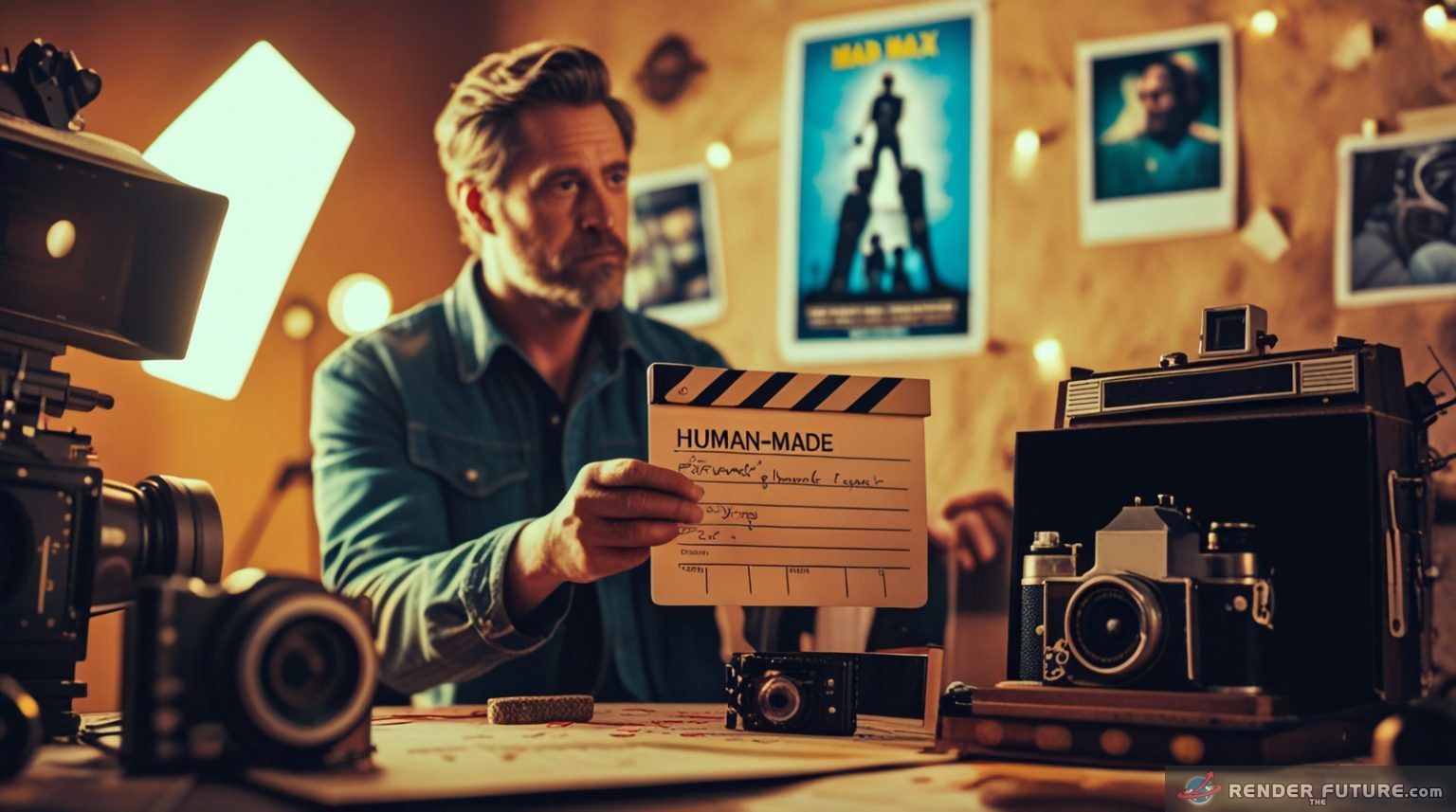 The future might surprise us. Just as Instagram made Polaroids cool again, AI could accidentally make us fall back in love with the beautifully imperfect, gloriously human messiness of real filmmaking.
The future might surprise us. Just as Instagram made Polaroids cool again, AI could accidentally make us fall back in love with the beautifully imperfect, gloriously human messiness of real filmmaking.
Because no algorithm can replicate that moment when an actor’s voice cracks in just the right way, or when a director fights for a shot they believe in against all odds. That’s the stuff that sticks to your ribs.
Conclusion: A New Golden Age of Cinema
The future of movie making isn’t about machines replacing artists — it’s about artists wielding machines to create the impossible. AI will draft scripts, robots will perform stunts, and VR will immerse us like never before.
But at its core, cinema will always be human. A well-told story, a breathtaking shot, a performance that moves us — these can’t be automated.
The best is yet to come.
Lights, camera… evolution.

References and Sources
- “The Science of 24 FPS: Why Movies Look Like Dreams” – Filmmaker’s Journal
Explains the psychological impact of frame rates on human perception. - “AI in Hollywood: Threat or Tool?” – Wired
https://www.wired.com/
Analyzes how AI is being integrated into film production. - “Virtual Reality and the Future of Filmmaking” – The Verge
https://www.theverge.com/
Discusses VR’s role in next-gen cinematography. - “How ‘Avatar 2’ Pushed CGI to New Limits” – Variety
https://www.variety.com/
Behind-the-scenes look at groundbreaking Avatar movie tech.




